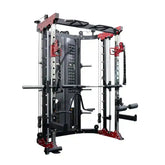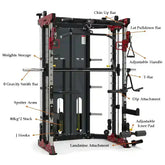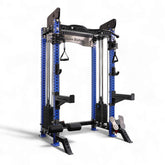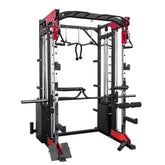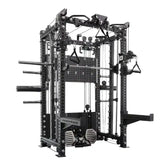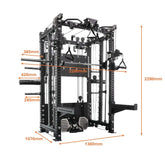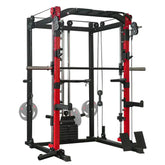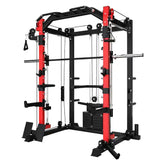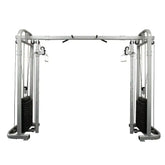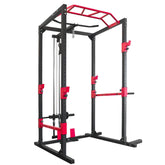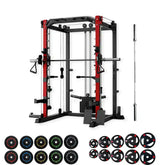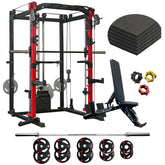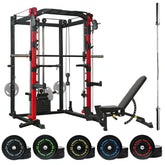What Is a Smith Machine?
A Smith machine is a strength-training station featuring a guided barbell that moves up and down along fixed rails.
This guided motion enhances stability, making it easier to maintain proper form and control during heavy or complex
lifts.
Key Components
- Guided barbell on linear bearings
- Vertical or angled track
- Safety catches / adjustable safeties
- Lockout hooks to rack the bar at any height
- Optional attachments such as pulleys, cable systems, pull-up bars, landmine attachments, and weight storage
Why the Guided Track Matters
It removes the need to balance the bar — perfect for solo training and for beginners who want to focus on technique
without added risk.
What Muscles Does a Smith Machine Work?
A Smith machine can train the entire body, depending on the exercise and attachments.
Upper Body
- Chest: bench press, incline press, decline press
- Shoulders: overhead press, upright row
- Back: bent-over rows, shrugs
- Arms: close-grip bench press, drag curls, tricep extensions
Lower Body
- Quads: front squat, back squat, split squat, hack squat
- Glutes: hip thrust, glute bridge
- Hamstrings: RDLs, good mornings
- Calves: standing calf raises
Core
- Standing presses
- Anti-rotation holds
- Smith machine rollouts
- Assisted core stability movements
Types of Smith Machines
Understanding the types helps buyers choose the right one for their space and training style.
1. Counterbalanced Smith Machines
- Built-in counterweight making the bar feel lighter
- Ideal for studios, commercial gyms and beginners
- Smooth, balanced bar path
2. Non-Counterbalanced Smith Machines
- Bar weight is the full true weight (often 15–20kg)
- Feels more like free-weight lifting
- Preferred by intermediate and advanced lifters
3. Pin-Loaded Smith Machines
- Integrated weight stacks
- Quick resistance adjustments
- Perfect for high-volume studios and commercial use
4. Plate-Loaded Smith Machines
- Uses Olympic weight plates
- Customisable load
- More affordable and versatile for home gyms
5. Multi-Functional Smith Machines (All-in-One Trainers)
The most popular home option. Usually includes:
- Smith machine
- Cable crossover or functional trainer
- Lat pulldown & low row
- Pull-up bar
- Landmine attachment
- Weight plate storage
- Adjustable safeties
This gives you a full gym in one compact footprint.
What Exercises Can You Do on a Smith Machine?
A Smith machine supports endless strength exercises — far more than most people realise.
Top 20 Smith Machine Exercises
- Back squat
- Front squat
- Hack squat
- Split squat
- Romanian deadlift
- Hip thrust
- Glute bridge
- Calf raises
- Bench press
- Incline press
- Decline press
- Shoulder press
- Upright row
- Bent-over row
- Drag curl
- Close-grip bench press
- Shrugs
- Good mornings
- Lunges
- Standing overhead press
Are Smith Machines Safe?
Yes — they are among the safest weightlifting tools available, particularly for solo training.
Key Safety Features
- Guided bar path
- Adjustable safety stops
- Ability to lock the bar at any height
- Lower risk of losing balance
- Lower risk of failed reps causing injury
Perfect For
- Home gyms
- Beginners
- Rehabilitative training
- Personal trainers
- Commercial gym settings
Smith Machine vs Barbell: Which Should You Choose?
Smith Machine Advantages
- Safer when training alone
- Great for high-volume hypertrophy
- Controlled movement makes technique easier
- Removes balance limitations
- Ideal for isolation exercises
- Easy to progressively overload
Barbell Advantages
- Works stabiliser muscles
- Feels more natural to advanced lifters
- Requires more balance and core activation
Best overall setup: A Smith machine + free weights for balanced strength development.
What to Look for When Buying a Smith Machine
A complete buyer’s checklist:
1. Frame & Steel Thickness
Look for heavy-duty steel (2–3mm thickness).
2. Linear Bearings
Ensure the bar path is smooth and quiet.
3. Safety Spotter Arms
These protect you from failed reps.
4. Maximum Weight Capacity
Choose a machine that matches your lifting goals.
5. Bar Weight & Counterbalance
Counterbalanced bars feel lighter; standard bars feel more like free weights.
6. Attachments & Expandability
- Cable crossover
- Lat pulldown system
- Low row station
- Dip handles
- Landmine attachment
- Pull-up bar
- Jammer arms (advanced)
7. Footprint & Space Requirements
- Width
- Depth
- Height
- Room for bench movement
8. Stability & Load Distribution
The machine should remain stable under heavy loads.
What Accessories Improve a Smith Machine?
- Adjustable weight bench
- Olympic weight plates
- Cable attachments
- Resistance bands
- Bar pad (hip thrusts)
- Landmine handle
- Lat pulldown bar
- Ankle straps
- Dip belt
How to Use a Smith Machine Properly
- Set your safety stops. Position them just below your natural range of motion.
- Position yourself correctly. Chest up, core braced, feet aligned with the bar path.
- Unrack safely. Lift slightly and rotate to disengage the hooks.
- Maintain control. Keep your core engaged throughout.
- Re-rack safely. Rotate the bar to lock it at any height.
Smith Machine Bar Weight Explained
- Counterbalanced: 5–10kg
- Standard Smith: 15–20kg
- Commercial heavy bars: 20–25kg
Who Is a Smith Machine Best For?
- Beginners learning proper form
- Home gym users training alone
- Bodybuilders focusing on hypertrophy
- Rehabilitation and controlled movement
- Personal trainers
- Commercial gym facilities
- Small spaces needing an all-in-one machine
Why Smith Machines Are Perfect for Home Gyms
A Smith machine can replace multiple pieces of equipment:
- Squat rack
- Barbell station
- Safety spotters
- Bench press station
- Cable system (in multifunction models)
All in one compact, safe and space-efficient system.
Can You Build Muscle With a Smith Machine?
Absolutely. Smith machines are excellent for hypertrophy due to stability and controlled movement.
Benefits
- Better mind–muscle connection
- Easier to hit failure safely
- Ideal for hypertrophy rep ranges
- Reduces balance limitations
- Allows higher training volume
Frequently Asked Questions
1. Is a Smith machine good for beginners?
Yes — it provides stability, safety and confidence.
2. Can I do squats on a Smith machine?
Absolutely. It is one of the safest ways to squat, especially at home.
3. Is a Smith machine good for glutes?
Yes — hip thrusts, glute bridges, split squats and RDLs are extremely effective.
4. How much space do I need?
- Width: ~2m
- Depth: 1.5–2m
- Height: 2.1–2.3m
- Plus clearance for bench movement
5. Do I need a bench?
Yes — for full-body training, a flat or adjustable bench is essential.
6. How often should I lubricate the bearings?
Every 3–6 months depending on usage.
7. Are Smith machines suitable for heavy lifters?
Yes — most commercial models support 250–350kg+ safely.
8. Can I assemble it myself?
Yes — although professional assembly is optional.
9. Do Smith machines replace free weights?
No — they complement them. The best gyms use both.
Final Takeaway: Why Buy a Smith Machine from AlphaGo?
- Commercial-grade durability
- Smooth linear bearings
- Heavy-duty steel frames
- Excellent value for price
- Fast delivery
- Wide range of multifunction models
- Trusted locations in Brisbane & the Gold Coast
- Ideal for both home gyms and professional studios
A Smith machine is one of the best investments you can make for safe, effective and long-term strength training.

